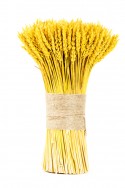 Everybody’s doing it . . . saying “No!” to bread, pasta, pastries . . . and other wheat-based items.
Everybody’s doing it . . . saying “No!” to bread, pasta, pastries . . . and other wheat-based items.
For many, it’s a matter of intestinal necessity (that pesky “gluten intolerance” we keep hearing about), while others see it as a weight-loss tool (a sure-fire way to reduce belly—and other unwanted—fat).
But what if you’re neither gluten-intolerant nor overweight? Are there other reasons to lose the wheat?
According to a growing number of medical doctors—such as New York Times’ bestsellers William Davis, a Milwaukee cardiologist who wrote Wheat Belly, and David Perlmutter, a Naples, Fla.-based neurologist who wrote Grain Brain
—the answer is a resounding, Yes!
Both make a convincing case against the ingestion of not only gluten, but wheat (and most grains!) in general.
They cite a litany of human suffering that can be linked to the humble wheat stalk . . . a list that’s far from pretty and includes everything from celiac disease (a condition marked by the inability to properly absorb nutrients due to a damaged intestinal lining) to Alzheimer’s disease, one of the most heartbreaking scourges visited on modern man.
The list is long and tedious, including neurological disorders (like schizophrenia, depression, autism, ADHD, dementia, epilepsy, seizures and migraines), appetite stimulation, diabetes, heart disease, kidney dysfunction, arthritis, asthma, acid reflux, irritable bowel syndrome, rashes, acne, tremors, twitches, weight-gain, osteoporosis, acidity, skin aging, hair loss—and even heroin-like addiction to the grain, itself.
Wheat, according to Davis, can “reach deep down into virtually every organ of the body, from the intestines, liver, heart and thyroid gland all the way up to the brain. In fact, there’s hardly an organ that is not affected by wheat in some potentially damaging way.”
Perlmutter agrees, calling gluten “our generation’s tobacco.”
But wait . . . Isn’t wheat an ancient food—full of nourishment and life? Doesn’t the Bible talk about “living bread” and include the prayer, “Give us this day our daily bread”?
If only life were so simple! The problem, it seems, is not what wheat has historically been, but what it has more recently become.
“Modern wheat,” according to Davis, “is no more real wheat than a chimpanzee is an approximation of a human.”
The problem, he believes, can be traced to an agricultural program formed in 1943 by the Rockefeller Foundation and the Mexican government at the International Maize and Wheat Improvement Center (IMWIC) just east of Mexico City. Designed to help Mexico achieve “agricultural self-sufficiency,” the program’s objective soon expanded into the noble goal of “reducing world hunger.”
As part of the program, wheat was aggressively hybridized to create new strains designed to be more high-yielding and better suited for cultivation. Once tall grains soon gave way to “exceptionally high-yielding dwarf wheat that was shorter and stockier”—characteristics that allowed it to “maintain (an) erect posture and resist buckling,” and mature faster than traditional strains; and seeds that once “clung tightly to the stem” were now looser, making threshing “easier and more efficient.”
By many accounts, the IMWIC’s work was a success. Countries around the world were able to cultivate crops like never before—and hungry people were fed. Indeed. So prevalent has been the use of such newer strains that one source places “dwarf and semi-dwarf” wheat at 99 percent of today’s worldwide wheat production.
But many see dangers lurking beneath the surface. Davis points out that “despite dramatic changes in the genetic makeup” of wheat during these tens of thousands of cross-breeding exercises, “no animal or human safety testing was conducted.”
The changes that can’t be seen are the most troubling. New proteins have been created by cross-breeding efforts—proteins that they didn’t exist in either parent wheat plant. In one experiment, 14 new gluten proteins were identified. In other words, cross-breeding produced proteins foreign to traditional wheat.
Perlmutter notes that modern grains may “contain up to 40 times the gluten of grains cultivated just a few decades ago” and Davis points out that celiac disease, which is gluten-induced, is “on the rise, increasing fourfold over the past 50 years,” a fact he believes “reflects the changes that wheat, itself, has undergone.”
It’s no wonder the human body is rebelling!
Wheat, despite its “healthy grain” image, harbors another dark secret—one that Perlmutter says has been known for more than 30 years: It “increases blood sugar more than table sugar.”
In fact, Perlmutter states that “few foods produce as much of a surge in blood glucose as those made with wheat;” and Davis agrees, stating that wheat products “elevate blood sugar levels more than virtually any other carbohydrate, from beans to candy bars.”
Unfortunately, high blood glucose causes inflammation, and inflammation, according to Perlmutter, is the “cornerstone of all degenerative conditions, including brain disorders.”
Those lovely cookies and pastries are looking a little less lovely!
But what about people who have no (discernable) signs of “wheat-induced” distress?
Unfortunately, Perlmutter calls gluten a “silent germ” that can “inflict damage without you knowing it.”
“We may all be sensitive to gluten in the same way an individual with celiac is,” he states. “We just don’t know it yet because there are no outward signs or clues to a problem happening deep within the quiet confines of our nervous system and brain.”
Indeed. Perlmutter estimates that as many as 40 percent of the population “can’t properly process gluten, and the remaining 60 percent could be in harm’s way.”
“The question we need to be asking ourselves is, What if we’re all sensitive to gluten from the perspective of the brain?”
So . . . What do Perlmutter and Davis recommend?
No ambiguity there. Davis contends that wheat is “the world’s most destructive dietary ingredient” and eliminating it will make you “sleeker, smarter, faster and happier” and Perlmutter contends that “gluten sensitivity represents the greatest and most under-recognized health threat to humanity.”
Their advice is simple: Pass (On!) the Wheat!
For those wondering how to make that happen, check out our story, “No Wheat? Now What?”
Copyright 2014-2020. Jonna Crispens. All rights reserved.


















